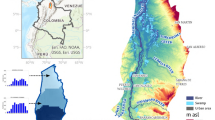Abstract
Subsoil and shallow groundwater surrounding the Luhuagang landfill site (LLS) have been contaminated by leachate that contains organic chemicals in Kaifeng, China. The composition and spatial distribution of organic pollutants in shallow groundwater near the LLS was investigated by analyzing 28 shallow groundwater samples that were collected in May 2010. The ambient severity method was used to evaluate the potential risks to human health and the environment from organic contaminants in the shallow groundwater. Volatile and semi-volatile organic compounds in the groundwater samples were screened using full-scan gas chromatography–mass spectrometry, and seven organic compounds were detected. 1,2-dichlorobenzene (1,2-DB), 1,2,3-trichlorobenzene (1,2,3-TCB), and 1,2,4-trichlorobenzene (1,2,4-TCB) were detected in all groundwater samples, while naphthalene was detected in 13 samples (detection rate 46.4 %). The highest 1,2-DB concentration was 277.45 μg/L, and all 1,2-DB concentrations were below the Chinese drinking water quality threshold of 1000 μg/L. Concentrations of 1,2,4-TCB, 1,2,3-TCB and naphthalene exceeded the Chinese drinking water quality limit in 6 samples, 3 samples, and 1 sample, respectively. 1,2-DB, 1,2,3-TCB, and 1,2,4-TCB have already formed a small contamination plume close to the landfill; however, their concentrations decrease in a northwest/southeast direction. Shallow groundwater around the LLS is severely contaminated by 1,2,4-TCB and 1,2,3-TCB, mainly as a result of either leachate from the landfill or refuse from the village. There are greater potential risks to human health and the environment from 1,2,4-TCB than from 1,2-DB and 1,2,3-TCB. These results will help support management of groundwater resources in this area.





Similar content being viewed by others
References
Baasel WS (1985) Economic methods for multipollutant analysis and evaluation. Marcel Dekker, New York, pp 188–297
Chen W, Song L, Gan N, Li L (2006) Sorption, degradation and mobility of microcystins in Chinese agriculture soils: risk assessment for ground water protection. Environ Pollut 144:752–758
Dong WH, Zhang Y, Lin XY, Taboure A (2013a) Adsorption studies of 1,2,4-Trichlorobenzene onto shallow aquifer media at the Luhuagang landfill site in Kaifeng, China. Environ Earth Sci 71:4353–4362
Dong WH, Kang B, Du SH, Shi XF (2013b) Estimation of shallow groundwater ages and circulation rates in the Henan Plain, China: CFC and deuterium excess methods. Geosci J 17:479–488
Dong WH, Zhang Y, Lin XY, Du SH (2014) Prediction of 1,2,4-trichlorobenzene natural attenuation of in groundwater at a landfill in Kaifeng, China. Environ Earth Sci 71:941–948
Du SH, Su XS, Zhang WJ (2013) Effective storage rates analysis of groundwater reservoir with surplus local and transferred water used in Shijiazhuang City, China. Water Environ J 27:157–169
Fan HJ, Shu HY, Yang HS, Chen WC (2006) Characteristics of landfill leachates in central Taiwan. Sci Total Environ 361:25–37
Flyhammar P (1997) Estimation of heavy metal information in Municipal Solid Waste. Sci Total Environ 198:123–133
Gao XY, Shi XR, Cui YB, Li M, Zhang RF, Qian X, Jiang Y (2011) Organic pollutants and ambient severity for the drinking water source of western Taihu Lake. Ecotoxicology 20:959–967
Ibe KM, Nwankwor GI, Onyekuru SO (2001) Assessment of ground water vulnerability and its application to the development of protection strategy for the water supply aquifer in Woerri, southeastern Nigeria. Environ Monit Assess 67:323–360
Kulikowska D, Klimiuk E (2008) The effect of landfill age on municipal leachate composition. Bioresour Technol 99:5981–5985
Lin XY, Tabouré A, Wang XY, Liao ZS (2007) Use of a hydrogeochemical approach in determining hydraulic connection between porous heat reservoirs in Kaifeng area, Henan, China. Appl Geochem 22:276–288
Liu F, Liu Y, Jiang DS, Zhang RF, Cui YB, Li M (2014) Health risk assessment of semi-volatile organic pollutants in Lhasa River China. Ecotoxicology 23:567–576
Peter K, Barlaz MA, Rooker AP, Baun A, Ledin A, Christensen TH (2002) Present and long term composition of MSW landfill leachate: a review. Crit Rev Environ Sci Technol 32:297–336
Qian JZ, Wang LL, Liu Y, Wu BR, Wang XM (2014) Distribution of nitrate and its implication for the contaminant source in groundwater of Huaibei Plain, Anhui Province. Geosci J. doi:10.1007/s12303-014-0051-5
Show KY, Lee DJ, Pan XL (2013) Simultaneous biological removal of nitrogen–sulfur–carbon: recent advances and challenges. Biotechnol Adv 31:409–420
Su XS, Xu W, Du SH (2014) Responses of groundwater vulnerability to artificial recharge under extreme weather conditions in Shijiazhuang City, China. J Water Supply 63(3):224–238
Su XS, Yuan WZ, Xu W, Du SH (2015) A groundwater vulnerability assessment method for organic pollution: a validation case in the Hun River basin, Northeastern China. Environ Earth Sci 73:467–480
Szelewski M (2004) Fast USEPA 8270 semivolatiles analysis using the 6890/5973 inert GC/MSD with performance electronics. Agilent Technologies, Publication 5898-1510EN, www.agilent.com/chem
US EPA (2009) Basic information about 1,2,4-Trichlorobenzene in drinking water, National Primary drinking water regulations, 816-F-09-004
Yu GM, Liu HY, Zhang TL, Su JW, Shen MT, Li W (2007) Assessment of the Organic Pollution and Its risk for the Surficial Ground Water in Hangzhou City. Resour Surv Environ 28:198–204 (Chinese with English Abstract)
Zhai YZ, Lei Y, Zhou J, Li MZ, Wang JS, Teng YG (2015) The spatial and seasonal variability of the groundwater chemistry and quality in the exploited aquifer in the Daxing District, Beijing, China. Environ Monit Assess 187:43
Author information
Authors and Affiliations
Corresponding author
Rights and permissions
About this article
Cite this article
Dong, W., Lin, X., Du, S. et al. Risk assessment of organic contamination in shallow groundwater around a leaching landfill site in Kaifeng, China. Environ Earth Sci 74, 2749–2756 (2015). https://doi.org/10.1007/s12665-015-4669-z
Received:
Accepted:
Published:
Issue Date:
DOI: https://doi.org/10.1007/s12665-015-4669-z




